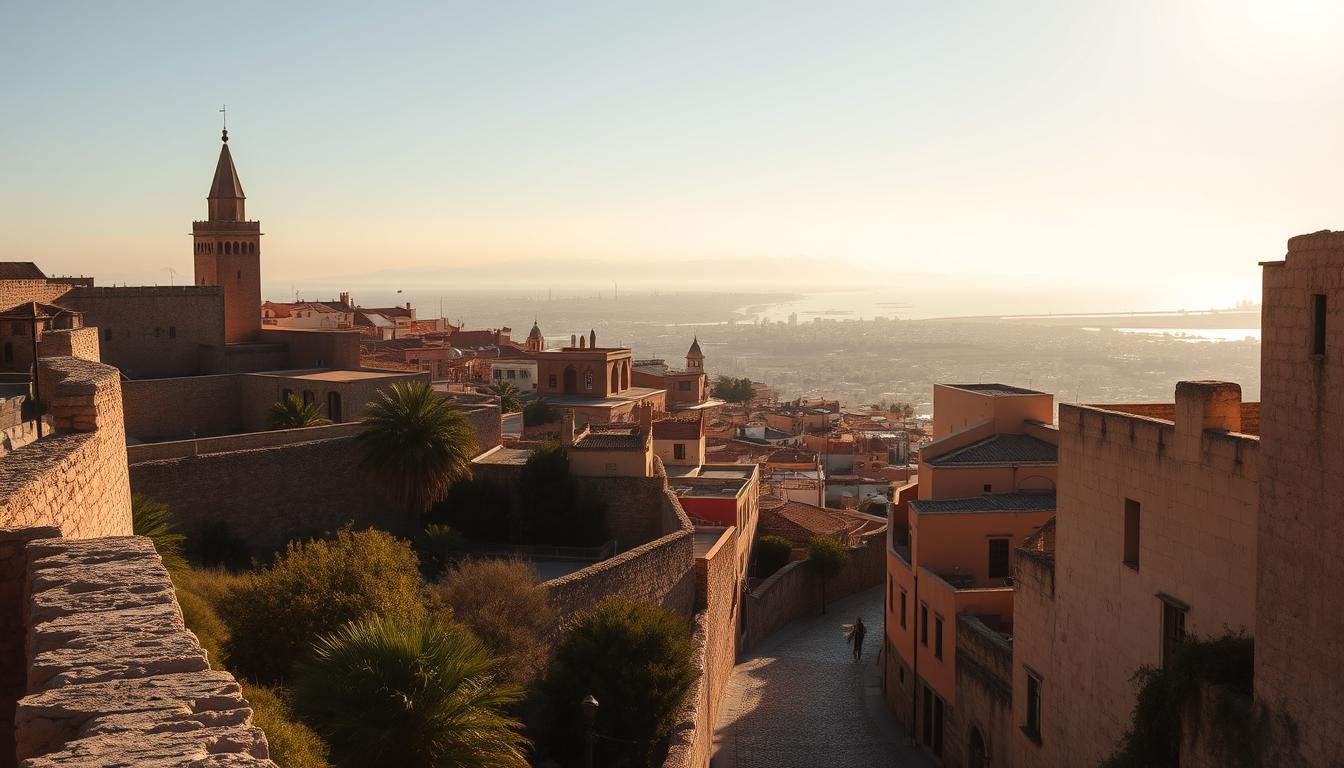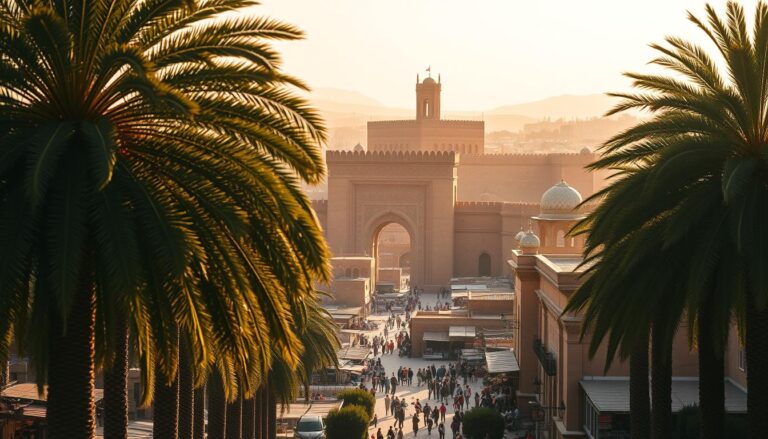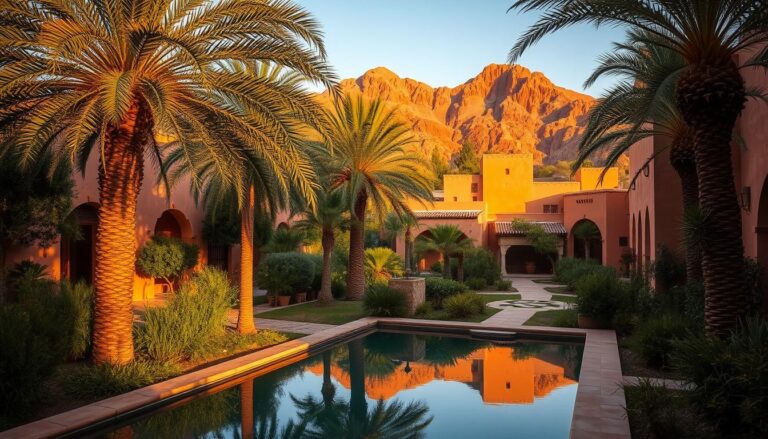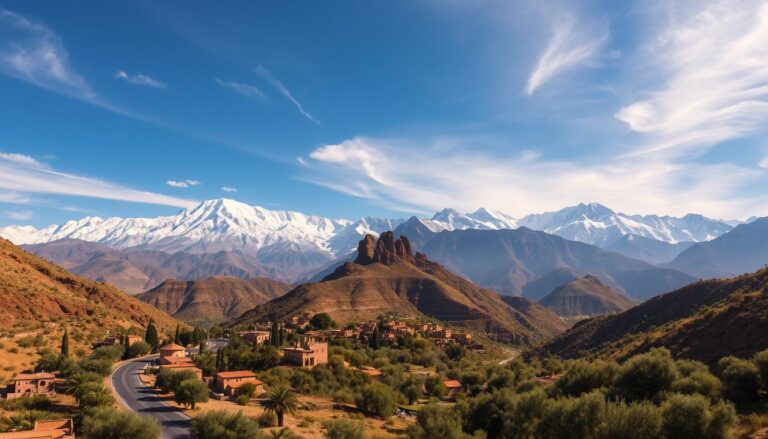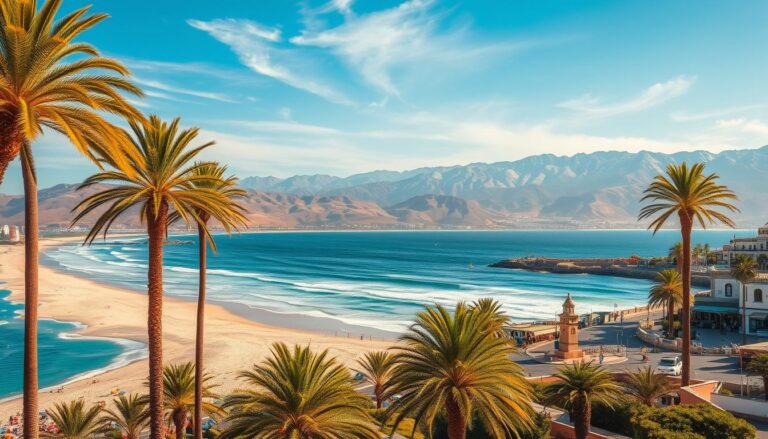Explore the Historic City of Rabat, Morocco
Table of Contents
Did you know one UNESCO World Heritage Site holds 2,000 years of layered history within its walls? This coastal gem blends ancient ruins with sleek tramways, offering travelers a rare mix of preserved heritage and modern comfort. As Morocco’s political heart, it welcomes visitors with wide boulevards and a relaxed vibe missing in busier destinations.
Walk through neighborhoods where Phoenician traders once bartered and French architects later designed art deco buildings. The Bou Regreg River splits the skyline, connecting historic kasbahs to a thriving arts district. You’ll find Roman ruins just minutes from rooftop cafes serving mint tea with ocean views.
What makes this capital unique? Its UNESCO status protects not just medieval ramparts but also 20th-century “garden cities” planned during colonial times. Leafy parks frame Hassan Tower’s unfinished minaret, while the tram whisks locals past artisan workshops selling handwoven textiles.
Key Takeaways
- Discover a UNESCO-listed destination blending ancient medinas with modern urban design
- Experience authentic culture without dense tourist crowds in walkable districts
- Explore coastal landscapes where a historic river meets the Atlantic Ocean
- Marvel at architectural contrasts from Roman ruins to French colonial landmarks
- Enjoy seamless navigation via Africa’s first tram system connecting key attractions
Introduction to Rabat Morocco
Imagine a coastal capital where mild ocean breezes soften the summer heat and winter rains breathe life into lush gardens. This UNESCO World Heritage city thrives along the Atlantic Ocean, blending Mediterranean climate comforts with urban energy. With a population exceeding 2 million, it maintains an inviting atmosphere where historic markets hum alongside modern tram stations.
Why You Should Visit This Capital City
You’ll find rare harmony here. Government complexes and royal residences share streets with family-run bakeries selling honey-drenched pastries. Unlike crowded cities, the capital’s walkable size lets you explore Roman ruins before lunch and attend a jazz festival by sunset.
The Atlantic coastline shapes daily life. Surfers ride waves near 12th-century fortresses while locals sip espresso on sunlit terraces. With average temperatures hovering near 70°F, outdoor adventures thrive year-round.
An Overview of Rabat’s Unique Charm
What makes this place special? Its population cherishes tradition while embracing progress. Artisans weave carpets using ancient techniques just blocks from eco-friendly tramlines. Over 22 inches of annual rainfall keep palm-lined boulevards vibrant, creating a green haven rare in North African capitals.
Urban planning here protects history without stifling growth. You’ll see solar panels on medieval rooftops and electric buses passing Almohad-era gates. This balance earned global recognition – 30% of the city’s area falls under heritage protection, yet innovation flourishes.
Discovering Rabat’s Rich History
How does a city become a living timeline? Layers of civilizations left their mark here, each era building upon the last. From ancient trading posts to pirate havens, this coastal hub tells stories through crumbling stones and preserved monuments.
From Phoenician Roots to Almohad Heritage
Your journey begins in the first millennium BC. Phoenician traders established outposts along the Atlantic, drawn to the river mouth’s strategic position. Romans later built Sala Colonia on the same site – today’s Chellah ruins still showcase their baths and temples.
The 12th century brought dramatic change. Almohad ruler Abu Yusuf Ya’qub al-Mansur envisioned a grand capital called Ribat al-Fath (“stronghold of victory”). Massive walls stretched beyond the original kasbah, though his 1199 death left Hassan Tower’s minaret forever unfinished.
Colonial Influences and the Road to Independence
Fast-forward to the 17th century. Spanish refugees created the Republic of Bou Regreg, transforming the area into a pirate base. Centuries later, French colonizers reshaped the city again. In 1912, they chose this coastal site over Fez for their administrative center, sparking urban renewal.
Post-independence in 1956 brought a pivotal decision. King Mohammed V kept the capital here, cementing its modern role. Today, you’ll see French colonial architecture blending with medieval ramparts – a testament to resilience through turbulent periods.
Navigating Iconic Monuments and Royal Landmarks
What do golden tombs and an unfinished minaret reveal about a nation’s soul? These landmarks stand as open-air history books, their pages written in marble and sandstone. You’ll find stories of ambition, devotion, and craftsmanship etched into every surface.
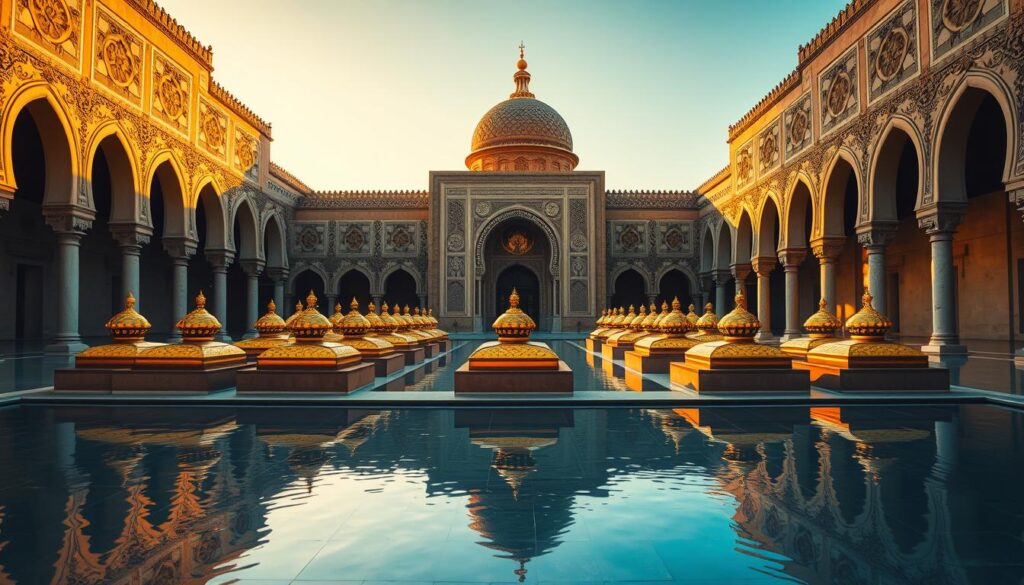
Where Kings Rest and Royals Reside
Step into the Mausoleum of Mohammed V, where sunlight filters through stained glass onto white onyx floors. Your eyes will lift to the honey-colored cedarwood ceiling, each geometric pattern hand-chiseled and gilded. Below lies the late king’s tomb, flanked by his sons’ resting places – a trinity of Moroccan leadership preserved in marble.
Half a mile west, the Royal Palace gates hint at secrets within. Though you can’t enter without special clearance, the 18th-century walls whisper tales of diplomatic receptions and royal proclamations. Guards in scarlet uniforms stand watch as the current monarch’s green-tiled residence glows under the North African sun.
Stone Giants of Ambition
Hassan Tower rises like a sandstone sentinel, its 144-foot frame showcasing Almohad architectural genius. You’ll count 200 columns around the tower’s base – remnants of what was meant to be Islam’s largest mosque. Construction halted in 1199, leaving this “minaret to nowhere” as a poignant reminder of grand visions.
Nearby, Chellah’s ruins blend Roman foundations with Islamic artistry. Storks nest in crumbling arches where merchants once traded, their clattering bills adding percussion to the wind’s ancient melody.
Exploring the Medina and Kasbah des Oudaias
What happens when a 12th-century fortress meets modern creativity? The Kasbah des Oudaias answers with cobalt-blue doorways framing ocean vistas and citrus groves perfuming ancient pathways. This elevated citadel lets you time-travel through rose-pink walls while keeping one foot in today’s vibrant culture.
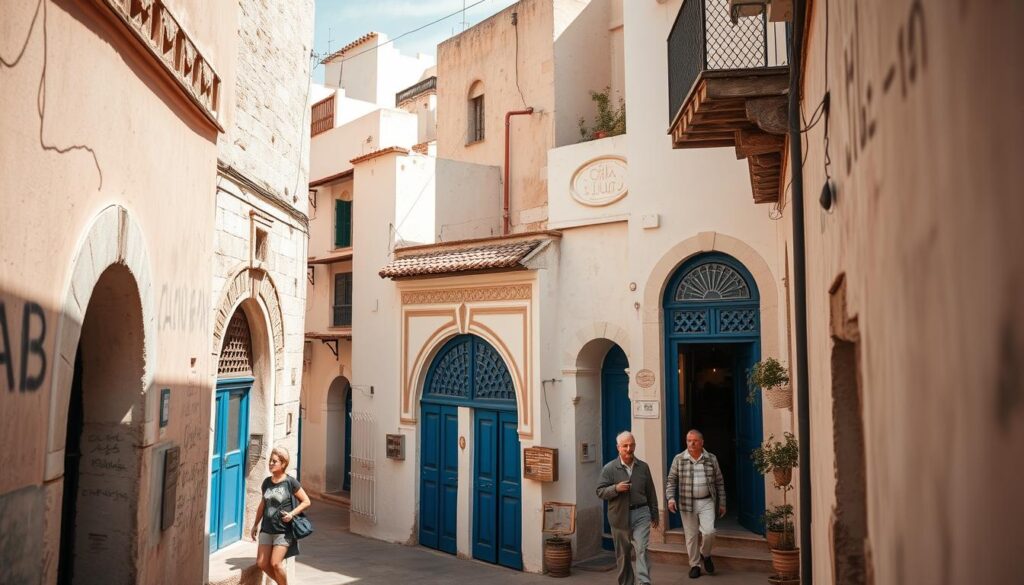
Winding Streets and Vibrant Souks
Step through the Kasbah des Oudaias’ arched gateway into a maze of cobbled streets that slope toward the Atlantic. Local artists display watercolors of the Bou Regreg River beside doorways painted in iconic blue-and-white patterns. Don’t miss the Andalusian Gardens – their geometric hedges frame orange trees heavy with fruit, creating nature’s own stained-glass window.
Your medina adventure begins on Rue des Consuls, where relaxed browsing replaces pushy haggling. Artisans here specialize in hand-stitched leather goods and polished silver tea sets displayed like museum pieces. The air carries notes of freshly ground spices and sea salt, proof you’re exploring working neighborhoods rather than tourist facades.
Climb to the Kasbah des Oudaias’ highest point at sunset. Watch fishing boats glide home as sunlight gilds the river’s surface. This view has inspired poets for eight centuries – today, it’s your turn to capture its magic through your camera lens or sketchbook.
Modern Urban Life and Cultural Experiences
Where ancient history meets tomorrow’s vision, this capital thrives as a laboratory for creative urban living. Glass towers reflect centuries-old ramparts while open-air concerts echo through Roman ruins. You’ll discover a city where cultural ambition walks hand-in-hand with environmental stewardship.
Art, Festivals, and Contemporary Architecture
Your eyes will widen at Zaha Hadid’s Grand Théâtre de Rabat, its curved concrete forms resembling desert dunes frozen mid-swell. Nearby, the 820-foot Mohammed VI Tower pierces clouds as Africa’s seventh-tallest skyscraper – a stainless steel exclamation mark declaring modern ambition.
Spring brings the Mawazine Festival, where global music icons perform for crowds exceeding 2.5 million. Prefer intimate vibes? Jazz au Chellah transforms 13th-century ruins into acoustic wonderlands under starry skies.
Eco-Responsible Developments and Green Spaces
Urban planners here think green first. Solar-powered tramways glide past vertical gardens cascading down apartment blocks. The Botanical Test Garden experiments with drought-resistant plants, while Bouknadel’s Exotic Gardens transport you through 17 thematic worlds – from bamboo forests to cactus labyrinths.
You’ll appreciate how parks double as social hubs. Families picnic beneath palms at Triangle de Vue, while skateboarders carve concrete waves at Hassan Park. Even stormwater gets recycled through clever filtration systems hidden beneath flower beds.
Uncovering Rabat’s Archaeological Treasures
What if you could walk through two civilizations in one afternoon? Chellah answers this question with crumbling columns and medieval gates that whisper stories across 2,000 years. This archaeological wonder reveals how empires rise, fall, and leave fragments for future generations to decode.
Ancient Ruins and Medieval Structures
Your feet will trace Roman roads laid during Sala Colonia’s heyday. Look down – Latin inscriptions still mark stones where chariots once rolled. Nearby, colorful mosaics showcase geometric patterns that inspired later Islamic designs. “This site captures the dialogue between cultures,” notes a local historian, “written in stone and tile.”
The Marinids transformed these ruins into a royal necropolis during their 14th-century rule. You’ll spot their legacy in the graceful minaret rising above Roman foundations. Storks nest atop weathered walls, their clattering bills adding percussion to the wind’s ancient melody.
Don’t rush through the gates leading to Islamic-era gardens. Fragrant orange trees frame pools where visitors once purified themselves before prayer. Allow two hours to absorb the layered history – few historic sites offer such clear evidence of successive golden ages.
This UNESCO-protected treasure proves civilizations don’t vanish completely. They leave blueprints in mortar and meaning, waiting for curious explorers to piece together their stories.
Savoring Moroccan Cuisine and Local Delights
Have you ever tasted a dish that whispers centuries of tradition? Follow locals to low-key spots where chicken tagine simmers in clay pots and street vendors craft flaky msemen pancakes. You’ll discover authentic flavors without inflated prices – the real magic happens where residents dine.
Clay Pots and Hidden Gems
Lines form early at unassuming restaurants serving Morocco’s iconic stew. A hearty chicken tagine with preserved lemons costs about Dh100 ($10.80), often cheaper than making it at home. Street stalls offer quick bites like harira soup or grilled sardines wrapped in paper.
Time your visit for lunch when aromas peak. Family-run spots near markets use recipes passed through generations. Don’t miss couscous Fridays – steaming semolina piled with veggies and tender meat, served only on this weekday.
For dessert, follow sugar-dusted trails to honey-drenched pastries. These sweet endings prove Rabat’s culinary scene thrives not in fancy eateries, but where locals share meals steeped in heritage.

